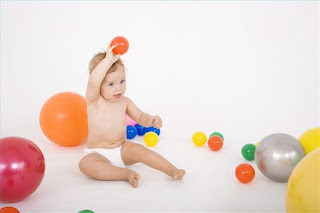We continue this week with the 3-part series of "Development of Early Ball Skills".
FLINGING A BALL: As soon as children are walking well, they
are ready to start flinging a ball. When
a child is able to walk with their hands at their sides (typically at 15 months
old or about 3 months after they start walking) they should have enough control
to stand and raise their arm to shoulder height.
For initial exposure to ball
throwing, I prefer a “Koosh” ball, small stuffed animal, or other soft object
that won’t roll away when it lands. (Again, I love a foam ball--see our Foam Ball Sets). This allows more time to
practice the actual skill of throwing rather than chasing the ball as it rolls
all over the house and gets trapped under furniture. When a stuffed animal lands, it usually stays
put and is easy to retrieve! The typical pattern children initially use when
starting to throw a ball is called “forward fling”. With the arm raised to about shoulder height,
kids will move their arm forward and fling the ball downward with a flick at
the wrist (wrist flexion).
OVERHAND THROW: It typically takes several months before an
actual overhand throw develops, typically between 27-28 months of age.
A true overhand throw requires a child to raise their hand over their
head, rotate their trunk and weight shift from one foot to the other while
bringing their arm forward and releasing the ball at the top of the arc of
movement. Frequently children who are
just learning to throw overhand will release prematurely and the ball will fall
off their hand backward instead of moving forward. Some children persist in a forward fling pattern
because they don’t know to raise their arm; I will demonstrate raising my arm
in the air over my head and say something like, “Arm up!” Then I release the
ball accompanied by, “Throw the ball!”
Getting the child in this ‘start’ position usually leads to a successful
throwing pattern.
Playing with balls is fun and
develops strength and coordination and leads to success in sports and other
coordinated movements. There are great Velcro Balls with Velcro Mitts that can develop hand strength and postural control during ball play.
Don't miss next week:
Development of Early Ball Skills Part III: Kicking and Catching a Ball
Blog Administrator: Trisha Roberts
proeducationaltoys@gmail.com
Copyright © 2017 TNT Inspired Enterprise, LLC, All rights reserved.
Unauthorized duplication is a violation of applicable laws.






No comments:
Post a Comment